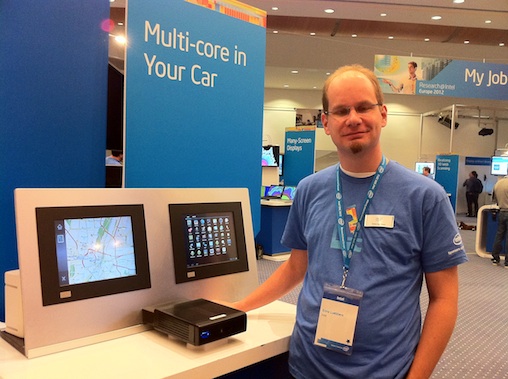Intel researchers envision a future of driverless smart cars that can be updated at any time with the latest technology and apps.
Intel hopes to play a major role in the new age, creating small, energy-efficient multi-core chips that can make cars more intelligent.
"In the next generation, we are talking about quad-core," said Michael Konow, an Intel engineering manager based in Germany.

Enno Luebbers, a research scientist at Intel Labs Europe, shows an Intel-based smart car system. Running a low-power processor similar to Intel's Atom chip, the system is running car- and driving-related apps, such as a navigation system, along with an Android-based entertainment system that has games and movies. (Photo by Sharon Gaudin/Computerworld)
"We are looking far ahead to safe driving cars," he said. "We would need a lot of compute power for a car to understand that if there's a ball rolling on the street, there might be a kid running after it. This is very, very difficult. As humans, we have intuition. We need to find a way to get this intelligence into the system."
Konow, who presented a smart car demo at Intel's European Research and Innovation Conference here today, told Computerworld that the auto industry is several years away from having many-core chips in cars, but that lab work on the technology is well underway.
"A car that drives autonomously and has a 100% guarantee that an accident won't happen would require a lot more compute performance," he said. "How much? We don't really know yet."
Today's cars, said Konow and Enno Luebbers, a research scientist at Intel Labs Europe, are getting overloaded with single-core chips. That's a problem, because eventually there won't be enough room for the additional chips that would be necessary to accommodate the ever-growing user demand for new functionality.
Adding a new function requires adding a new chip, said Konow. That means "you [might need] more than a 100 single cores in one high-end car," he said. "You cannot keep up this trend."
With so many single-core chips stuffed into one vehicle, onboard computer systems are becoming too large and complicated, he said.
The goal now is to save power and space, "which is critical because there is basically no space left," added Konow. "[Researchers] are trying to come up with weird shapes of boxes to squeeze them into the tiny amount of space left."
When automakers are able to integrate multi-core chips -- from quad-core to 8-core, 12-core and beyond -- into vehicles, they'll be able to add a lot more functionality, such as updated navigation options, more safety features and social applications.
Today, you have to buy a new car if you want the latest automotive apps. In the future, automakers will offer programmable cars, and users will be able to simply download new apps or upgrades if they want state-of-the-art systems, say Intel execs.
"It's almost like 'What applications wouldn't you want in your car?'" said Intel CTO Justin Rattner. "Once the car is a programmable platform, you'll see all kinds of innovation."
Rattner noted that the smarter cars could work together to make commutes easier.
For instance, cars could have sensors, cameras and computer chips programmed to report potholes to road maintenance crews, and to report traffic jams or accidents to other cars in the area.
In-car apps also could tell drivers which local parking garage has spaces available, or if any of their friends are driving nearby.
"We'll start thinking of our cars more like we think of our laptops and phones -- updateable," said Luebbers.
"For me, it's about synthesis," said Martin Curley, director of Intel Labs Europe. "We're thinking about how these can be integrated into a system of systems that helps us achieve a sustainable society."
Luebbers said a key challenge for engineers working on smarter cars is to ensure safety and security. It's one thing for an entertainment system to be breached; it's another for hackers to access a rearview monitoring system, for instance.
"One of the main challenges is integrating functions of different criticality," he said. "You have to treat the testing and development differently."
A higher level of security will be necessary when we start driving connected cars.
"Over the last 20 or 30 years, [onboard car computers] weren't built with security in mind. It was not required," said Konow. "[Automakers] were looking to save costs. They did not need to design it to be secure."
Widespread connectivity, though, presents the potential for significant problems, he said. "[Automakers] don't want to re-engineer a whole system, but have to find a way to protect systems from external attacks."
Luebbers also noted that car makers have traditionally focused on making sure vehicles did not fail by accident. Now they have to focus on making sure they do not fail because of a digital attack.
That, he said, forces OEMs to think about security in a new way.





